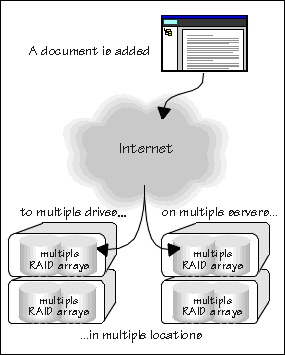
How safe is your data?
Let's agree that you have a lot of valuable data that is stored
in document form: images, word-processing documents, text files,
pictures, photos--even music or video files. How safe is that
data?
Documents disappear...
Businesses around the world depend upon documents--and those documents
can be destroyed. You can have a catastrophic loss--a fire, a building
collapse, even a fire sprinkler leak--but lots of times documents are
lost for the simplest of reasons: a briefcase left on the plane,
a mistake by the post office, documents taken home by an employee and
never returned. Lots of times documents disappear simply because they
have been filed in the wrong place. Why the document disappeared
is certainly important: but once it's gone, what do you do?
Document management: the answer
A document management system helps you keep track of documents--and
helps you replace those documents if the "hard copies" are lost. But....
What happens if a fire sprinkler goes off over the server that stores
your document management system?
Backup tapes aren't as useful as you might think
We're all in favor of tape backups (in fact, the technology mavens
around here can be positively annoying about the subject). But if you're
adding 14,000 documents per day to your document management system,
how useful is the backup tape from yesterday? If you have 400
employees who depend upon your document system, restoring from yesterday's
tape represents an immense loss of payroll time. Backing up is still a good
idea--as a last resort--but you need real-time security. You need
redundancy.
How redundant can you get?
Tens of thousands of new documents are entrusted to ObjectBaseX every
day. Our clients expect complete data security--and instantaneous
retrieval. We store those documents securely using a layered approach
to data storage:
- Redundant server facilities: ObjectBaseX maintains server facilities in different buildings, using different Internet connections, with different cable paths.
- Redundant Internet connections prevent outages resulting from a lost internet connection.
- Fault tolerant servers prevent outages caused by common failures. Each server has redundant network adapters, redundant fibre interfaces, and redundant power supplies. Additionally there are hot standby servers which are quickly configured to replace any failed server.
- Redundant data servers: Each document added to ObjectBaseX is stored on multiple disk arrays. Each database is assigned a primary and a secondary disk array--so in the event of a failure there is no interruption in service
- Redundant data storage: Documents are stored on two distinct RAID arrays. Additionally, the data is stored on a server off-site and archived to CDR or DVDR and stored offsite. And yes ... if you're wondering ... we do backup to tape as well.
- Redundant disks Using a technology called RAID (Redundant Array of Inexpensive Disks), each document is written to at least three different disk drives in a RAID array. Using new RAID-6 technology prevent failure even if two disk drives fail simultaneously.
Keeping score? If your databases are maintained in multiple facilities, on multiple servers, on multiple drive arrays, with three or more drives in each array, each document you add to ObjectBaseX can be stored in 24 or more locations.